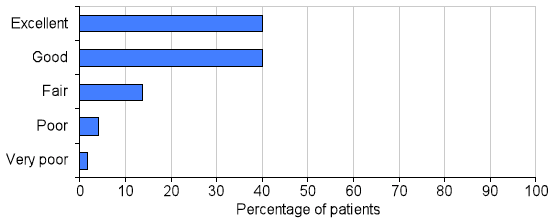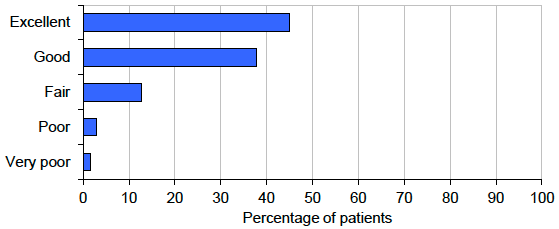Scottish Inpatient Patient Experience Survey 2012 Volume 1: National results
The Better Together Scottish Patient Experience Inpatient Survey is a postal survey, first conducted in early 2010, with the aim of establishing the experience of a sample of people aged 16 years and over who had a recent overnight hospital stay. The survey covers six specific areas of inpatient experience: admission to hospital; the hospital and ward; care and treatment; hospital staff; arrangements for leaving hospital; and care and support services after leaving hospital.
3 RESULTS – ADMISSION TO HOSPITAL
Summary
3.1 The majority of patients were positive about their experiences of admission to hospital. Overall 80 per cent of patients rated their admission to hospital as either excellent or good with no change since last year. However Accident and Emergency department (A&E) patients were less content regarding the information provided on waiting times in A&E; only 49 per cent of patients strongly agreed or agreed that they were told how long they would have to wait. More information on these results and other questions relating to hospital admission are outlined below.
Emergency or planned in advance
3.2 Patients who responded to the survey had either been admitted to hospital as an emergency / urgent admission (61 per cent) or had their stay planned in advance (39 per cent).
3.3 Of the emergency and urgent patients, 72 per cent went to the A&E when they arrived at hospital.
Views on individual aspects of admission
3.4 Patients were asked to rate their admission to hospital. Chart 1 shows that overall 80 per cent of patients rated their admission to hospital as excellent or good.
Chart 1 Overall rating of admission to hospital

3.5 A&E patients were asked to rate their care and treatment that they had received in A&E with 83 per cent rating it as excellent or good (Chart 2).
Chart 2 Overall, how would you rate the care and treatment you received during your time in A&E?

3.6 Patients were asked about individual aspects of their admission to hospital which included communication, length of time waiting to be seen or admitted, and care and treatment in A&E. The results are presented in Table 1. There were no statistically significant changes since the last survey in 2011 in any of the questions about admission to hospital (Table 1).
Table 1 Summary of the results to questions about patients' admission to hospital
| Statement or question | 2012 | Change from 2011 in Positive % | |||
|---|---|---|---|---|---|
| Total base (unweighted) | Negative % | Neither positive nor negative % | Positive % | ||
| Emergency or urgent patients | |||||
| In A&E I was told how long I would have to wait | 7,388 | 31 | 20 | 49 | 0 |
| In A&E I was told what was happening in a way I could understand | 9,762 | 9 | 8 | 83 | -1 |
| Overall, how would you rate the care and treatment you received during your time in A&E? | 10,626 | 4 | 13 | 83 | +1 |
| Waiting list and planned in advance patients | |||||
| If your hospital visit was planned in advance how did you feel about the length of time you waited to be admitted to hospital after being referred? | 10,546 | 12 | N/A | 88 | -1 |
| Did the information you were given before attending hospital help you understand what would happen? | 10,436 | 4 | N/A | 96 | 0 |
| All patients | |||||
| From the time you arrived at hospital, how did you feel about the time you had to wait to get to a bed on the ward? | 27,439 | 13 | N/A | 87 | 0 |
| Overall how would you rate your admission to hospital? | 27,448 | 6 | 14 | 80 | 0 |
3.7 The highest and lowest positive percentages on individual aspects of admission, which are unchanged from the 2011 results, both refer to communication with patients.
- The highest positive percentage (96 per cent) refers to the information patients were given before attending hospital when they had a planned admission;
- The lowest (49 per cent) refers to patients in A&E being told how long they would have to wait.
Length of time waiting in A/E
3.8 Until 2008/09 there was an NHS target that 98 per cent of patients should not wait more than four hours in A&E. Although it is no longer a target, it is still a standard that NHS Boards are expected to meet. We compared data on the standard with the inpatient survey data and found that in hospitals where patients are more likely to wait more than four hours, they are also more likely to not be told how long you have to wait.
Waiting to be admitted after being referred
3.9 On 31 March 2011 a new national standard was introduced, by which patients should not wait more than 9 weeks (previously 12 weeks) between the time they were placed on a waiting list and the time they were admitted in hospital for an inpatient or day case treatment. This change took place halfway through the period covered by this survey. Information published by ISD shows that only three per cent of patients who attended hospital during the period covered by the survey had to wait longer than 9 weeks4. In the inpatient survey, based on their experiences, 11 per cent of patients whose hospital visit was waiting list or planned in advance felt that the time they had to wait was too long. One per cent of patients felt that the time they had to wait was too short.
Contact
Email: Gregor Boyd
There is a problem
Thanks for your feedback